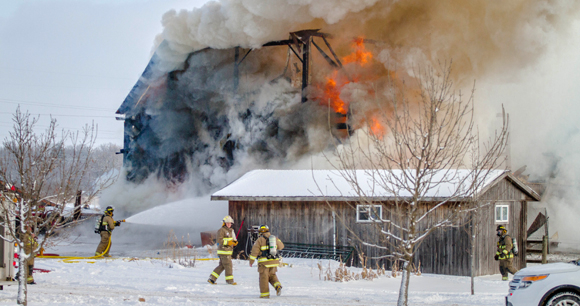
New barn fire research reveals that industrial operations continue to ignore simple fire prevention methods
Washington, DC—More than 681,000 farm animals perished in potentially preventable barn fires in 2021, according to an Animal Welfare Institute (AWI) analysis of media reports released today. This follows the worst year on record for fatal barn fires and brings the total number of farm animal deaths in the last two years alone to a staggering 2.3 million.
Though these numbers are shocking, they likely fail to represent the full scale of the problem. Fire departments and municipalities are not required to report the number of animals killed in fires. Additionally, based on records received by AWI through public records requests, even the departments that do submit fire incident reports to the US Fire Administration fail to acknowledge animal deaths, including in the most extreme cases that involve hundreds of thousands of fatalities.
Most often, the cause of barn fires is not conclusively determined. Many, however, are believed to result from electrical malfunctions or defective/improperly placed heating devices. In other cases, faulty equipment or machinery has been the suspected cause.
“Although effective fire suppression methods are available, the industry continues to allow millions of helpless farm animals to burn to death without changing course,” said Dena Jones, farm animal program director at AWI. “Barn fires aren’t a necessary evil—they can be prevented with proper planning, including such simple steps as installing smoke detectors or repairing faulty space heaters.”
Of the 113 fires tracked by AWI in 2021, New York and Pennsylvania reported the most for the second consecutive year (14 in New York), (13 in Pennsylvania), followed by Iowa (9), and Michigan, Ohio and Minnesota (8 each).
Consistent with previous years, chickens accounted for the overwhelming majority of farm animals tragically killed in fires last year (as reported by the media). As was the case in 2020, the three largest fires that occurred in 2021 all involved egg-laying hens in industrial-scale cage-free facilities, even though only 30 percent of all hens are cage-free. Collectively, these incidents took the lives of 433,000 hens, or nearly 64 percent of all animals killed in barn fires in 2021. As large-scale producers increasingly transition to cage-free housing, AWI suspects that high levels of dust, alone or in combination with litter, may contribute to the number and severity of fires in cage-free barns.
Additionally, more than 40,000 pigs, confined in concentrated animal feeding operations (CAFOs), perished in barn fires last year.
“Disaster is all but assured in conventional, industrial farming operations, which cram animals by the thousands into barns with no chance of escape,” Jones said. “While some farm animals die almost immediately as fires rage through barns, others have to be euthanized later due to severe burns and smoke inhalation.”
In total, more than 5.8 million farm animals have been killed in barn fires since 2013, when AWI began tracking these statistics.
A newly updated AWI report, “Barn Fires: A Deadly Threat to Farm Animals,” points to the increasing devastation caused by barn fires from 2018 through 2021.
Among the major findings:
- During the four-year period, 539 fires killed nearly 3 million animals.
- The average number of animals killed in barn fires each year was more than 748,000 animals, a 36 percent increase from the number of annual deaths reported in the previous study period (2013–2017).
- Nearly 98 percent of the farm animals killed were poultry, with egg-laying hens accounting for the largest share of fatalities, followed by chickens raised for meat.
- Individual fires had catastrophic consequences. The 10 largest fires—roughly 2 percent of the total number of barn fires—were responsible for 75 percent of farm animal deaths.
- As was documented in the previous barn fire report, barn fires happened most often in the Upper Midwest and Northeast. The five states with the highest number of barn fires were New York, Ohio, Pennsylvania, Michigan, and Wisconsin.
- The majority of barn fires occurred in colder weather, with more than twice as many fires occurring during the winter compared to summer.
The report lists several recommendations that could potentially save thousands of farm animal lives. These include improving operational protocols, such as performing annual inspections and implementing fire safety training for employees. Moreover, producers should invest in structural renovations, such as smoke detection systems and on-site water storage units in areas that have little access to reliable water sources.
While AWI believes the onus is on the industry, which profits from these animals, to spare them from excruciating deaths, government officials must be willing to intervene when companies fail to act. At minimum, state government agencies should incorporate the National Fire Protection Association’s Fire and Life Safety in Animal Housing Facilities Code (NFPA 150) into their state fire codes and improve the tracking and recording of these incidents to better understand the scale of the problem.
Marjorie Fishman, Animal Welfare Institute
[email protected], (202) 446-2128
The Animal Welfare Institute (awionline.org) is a nonprofit charitable organization founded in 1951 and dedicated to reducing animal suffering caused by people. AWI engages policymakers, scientists, industry, and the public to achieve better treatment of animals everywhere—in the laboratory, on the farm, in commerce, at home, and in the wild. Follow us on Facebook, Twitter, and Instagram for updates and other important animal protection news.